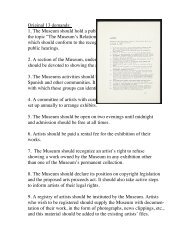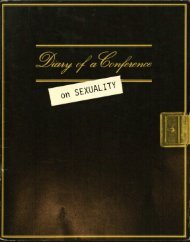Helen Molesworth on Lee Lazano - Dark Matter Archives
Helen Molesworth on Lee Lazano - Dark Matter Archives
Helen Molesworth on Lee Lazano - Dark Matter Archives
You also want an ePaper? Increase the reach of your titles
YUMPU automatically turns print PDFs into web optimized ePapers that Google loves.
Art Journal: Tune in, turn <strong>on</strong>, drop out: the rejecti<strong>on</strong> of <strong>Lee</strong> Lozano<br />
2008/02/25 12:14 PM<br />
FindArticles > Art Journal > Winter, 2002 > Article > Print friendly<br />
Tune in, turn <strong>on</strong>, drop out: the rejecti<strong>on</strong> of <strong>Lee</strong> Lozano<br />
<str<strong>on</strong>g>Helen</str<strong>on</strong>g> <str<strong>on</strong>g>Molesworth</str<strong>on</strong>g><br />
This is a story about a woman who rejected two different communities. A successful New York-based artist in the 1960s, by the early<br />
1970s <strong>Lee</strong> Lozano (1930-1999) was a woman who stopped speaking to women and an artist who had aband<strong>on</strong>ed the New York art<br />
world. Largely forgotten by art history, Lozano is now experiencing something of a small renaissance. Yet the new art world attenti<strong>on</strong><br />
shies from her rigorous aband<strong>on</strong>ment of both it and the world of women, wanting instead to valorize her paintings, and to commend<br />
the prescient nature of her c<strong>on</strong>ceptual pieces. But I remain curious, fascinated even, by the extreme nature of her rejecti<strong>on</strong>, and before<br />
merely repatriating her want to think through why it is that the refusal of women feels c<strong>on</strong>summately pathological and the rejecti<strong>on</strong><br />
of the New York art world residually idealistic.<br />
Lozano went to New York as a painter in the early 1960s. Her first major body of paintings was a rough-and-tumble mixture of cocks<br />
and cunts that morph together, mix ineluctably with, and transform into a variety of tools--screwdrivers, bolts, and hammers. The<br />
paint is thick, creamy, and sexy, and the overall images are arresting, as if the carto<strong>on</strong> style of Philip Gust<strong>on</strong> had somehow<br />
encountered c<strong>on</strong>temporary cyborg fantasies of a complete merger of body and machine. The sexuality imaged in these paintings and<br />
drawings, all d<strong>on</strong>e in the early 1960s, is hardly the soft-core liberati<strong>on</strong> offered by the then recently founded Playboy. It lends itself<br />
more to accounts of sexuality that stem from Freud's theory of the polymorphous sexuality of children or Bataille's Story of the Eye,<br />
which evokes a body that experiences a kind of perpetual slippage of meaning and significati<strong>on</strong>--tits become balls, and balls become<br />
eyes, and eyes are like cunts, and so <strong>on</strong>. A polymorphously perverse account of sexuality lends itself to a f eminist analysis, as it<br />
refuses to render the body and its sexuality hierarchical and implies instead a decentered experience of the body less dependent up<strong>on</strong><br />
visi<strong>on</strong>, voyeurism, spectacle, and objectificati<strong>on</strong>. Lozano's evocati<strong>on</strong> of this body is raucous, muscular, and simultaneously disturbing<br />
and deeply erotic (not that those two attributes are always different).<br />
Lozanos oeuvre includes two other major bodies of work. One is a series called the Wave Paintings, each oil-<strong>on</strong>-canvas work made<br />
according to a self-generated mathematical system that determined the number of waveforms in each painting. The relatively<br />
minimalist appearance of these c<strong>on</strong>ceptually derived paintings belies the task-based or endurance qualities of their producti<strong>on</strong>. Each<br />
painting was completed in <strong>on</strong>e sitting, but the lengths of the sittings varied dramatically: "The 2-Wave, for instance, lasted <strong>on</strong>ly eight<br />
hours, while 96-Wave required three c<strong>on</strong>secutive days of relatively uninterrupted labor." (2) The Wave series was mammoth,<br />
culminating in 192-Wave, which, <strong>on</strong>ce completed in 1970, marked the culminati<strong>on</strong> of Lozano's career as a painter.<br />
While Lozano painted, she also maintained a journal filled with what she called "word pieces." Lozano was an early practiti<strong>on</strong>er of<br />
C<strong>on</strong>ceptual works; these, often handwritten, usually in block letters <strong>on</strong> graph paper, involved durati<strong>on</strong> and the assignment of a task,<br />
or set of prescribed activities, for the artist to complete. Lozano's notebooks are filled with instructi<strong>on</strong>s to herself--ranging from how<br />
much pot to smoke (as much as possible), to what to do with all the printed announcements she received from galleries (throw them<br />
in a pile <strong>on</strong> the studio floor, or throw them out the window). Ultimately, she notes in her journal, she c<strong>on</strong>siders these works<br />
"drawings," eliminating any distincti<strong>on</strong> between them and her more traditi<strong>on</strong>al studio practice.<br />
In many regards, Lozano's most important word piece was the <strong>on</strong>going Dialogue Piece, started in 1969, in which she invited people<br />
into her studio for the sole purpose of discussi<strong>on</strong>. While the journal notes have a certain voyeuristic appeal (the list of 1960s<br />
luminaries is remarkable), Lozano is quite particular about never divulging the specific c<strong>on</strong>tent of the discussi<strong>on</strong>, thereby drawing a<br />
line between the public and private dimensi<strong>on</strong>s of the work. So while Dialogue Piece operates in the traditi<strong>on</strong> of the twentieth-century<br />
avant-garde, by exploring the increasingly porous boundaries between art and life, it also maintains a register of privacy not often<br />
associated with such work.<br />
http://findarticles.com/p/articles/mi_m0425/is_4_61/ai_96134613/print<br />
Page 1 of 4
Art Journal: Tune in, turn <strong>on</strong>, drop out: the rejecti<strong>on</strong> of <strong>Lee</strong> Lozano<br />
2008/02/25 12:14 PM<br />
Dialogue Piece also typifies what I see as the primary thrust of Lozano's work: the desire to use art to live a highly examined, and<br />
hence thoughtful, life. If <strong>on</strong>e of art's traditi<strong>on</strong>al roles has been to c<strong>on</strong>solidate and focus attenti<strong>on</strong> and percepti<strong>on</strong> <strong>on</strong> an object, then<br />
Lozano used art to train her attenti<strong>on</strong> <strong>on</strong> the public and private functi<strong>on</strong>s of herself as an artist. In so doing, Dialogue Piece<br />
establishes several artistic aims: here, art is identified first and foremost as a vehicle to foster communicati<strong>on</strong>, so much so that<br />
dialogue is treated as a process to be valued over and above the producti<strong>on</strong> of a final object. That being said, the work uses art as a<br />
tool to give value to the ineffable quality of interpers<strong>on</strong>al relati<strong>on</strong>s, as opposed to bestowing value solely up<strong>on</strong> the world of objects. It<br />
follows then that in Dialogue Piece Lozano is deploying the category art as a force to legitimate a way of being in the world. This is<br />
why I think Dialogue Piece is structured around the artist's studio: by exploiting her identity as "artist," and the preestablished<br />
legitimacy of the studio as a space dedicated to the producti<strong>on</strong> of art, Lozano was able to establish that the most important aspect of<br />
artistic producti<strong>on</strong> and her life came together under the rubric "dialogue." The category of art both permitted this activity and gave it<br />
a value it might not otherwise have had. To focus primarily <strong>on</strong> dialogue is also to focus almost exclusively <strong>on</strong> process as opposed to<br />
product (at precisely the moment process is entered into the downtown New York vocabulary),to such an extent that Lozano utterly<br />
slips out from under the problem of art as commodity. The utopian dimensi<strong>on</strong> of this project seems, in retrospect, utterly of its time.<br />
These three bodies of work exhibit an extraordinary range of artistic interests and practices that c<strong>on</strong>fuse certain art-historical<br />
prejudices. Here is an artist who painted within the parameters of both C<strong>on</strong>ceptual and performance art; who, when she painted in a<br />
brawling, figurative, expressi<strong>on</strong>istic style, slipped under the wires of both the dominant painting styles of the day, Abstract<br />
Expressi<strong>on</strong>ism and Pop, and who all the while experimented with C<strong>on</strong>ceptual art's systematic refusal of the primacy of the visual in<br />
art. Well known at the time, Lozano had all of the markers of a successful New York art career: she showed at Greene Gallery; was<br />
reviewed in Art News and Artforum; was included in Lucy Lippard's group exhibiti<strong>on</strong>s; and had a modest, <strong>on</strong>e-pers<strong>on</strong> exhibiti<strong>on</strong> of<br />
the Wave Paintings at the Whitney. Another indicati<strong>on</strong> of both her art-world stature and her political leanings was her participati<strong>on</strong><br />
in the Art Workers Coaliti<strong>on</strong>. Asked to submit a statement for the small publicati<strong>on</strong> Open Hearing, Lozano put forwa rd the following<br />
text:<br />
For me there can be no art revoluti<strong>on</strong> that is separate from a science revoluti<strong>on</strong>, a political revoluti<strong>on</strong>, an educati<strong>on</strong> revoluti<strong>on</strong>, a drug<br />
revoluti<strong>on</strong>, a sex revoluti<strong>on</strong> or a pers<strong>on</strong>al revoluti<strong>on</strong>. I cannot c<strong>on</strong>sider a program of museum reforms without equal attenti<strong>on</strong> to<br />
gallery reforms and art magazine reforms which would aim to eliminate stables of artists and writers. I will not call myself an art<br />
worker but an art dreamer and I will participate <strong>on</strong>ly in a total revoluti<strong>on</strong> simultaneously pers<strong>on</strong>al and public. (3)<br />
In this 1969 statement, the utopian idealism of Dialogue Piece is extended even further. In her refusal to hold the category of art<br />
separate and distinct from other activities, Lozano exhibits a propensity toward critique. Her insistence <strong>on</strong> more comprehensive<br />
reform articulates a then-nascent idea that the art world is a complex system encompassing not <strong>on</strong>ly the museum but the<br />
gallery/magazine nexus as well. True to her word, c<strong>on</strong>current with her reading the above statement at an Art Workers Coaliti<strong>on</strong><br />
meeting Lozano was at work <strong>on</strong> her General Strike Piece. In a typewritten notati<strong>on</strong> she stated: "Gradually but determinedly avoid<br />
being present at all official or public 'uptown' functi<strong>on</strong>s or gatherings related to the 'art world' in order to pursue investigati<strong>on</strong> of total<br />
pers<strong>on</strong>al and public revoluti<strong>on</strong>. Exhibit in public <strong>on</strong>ly pieces which further sharing of ideas and informati<strong>on</strong> related to total pers<strong>on</strong>al<br />
and public revoluti<strong>on</strong> [artist's emphasis] And so her withdrawal and total revoluti<strong>on</strong> began. While some of the word pieces were<br />
being shown, Lozano began to document her withdrawal from the art world, including her withdrawal from the political activities of<br />
the Art Workers Coaliti<strong>on</strong>, registered in part by a journal entry that describes her boredom and dissatisfacti<strong>on</strong> with a subcommittee<br />
meeting of women involved with Art Workers at Lucy Lippard's loft. Shortly after this encounter, Lozano wrote, 'Decide to boycott<br />
women," beginning a work that was to define the rest of her life.<br />
I want to take a minute here to describe the terms of these simultaneous withdrawals. Lozano's rejecti<strong>on</strong> of the New York art world<br />
meant that she left New York for Dallas, where she no l<strong>on</strong>ger attended art-world events or produced art objects. She c<strong>on</strong>tinued her<br />
intense interest in dialogue, reading avidly and speaking to artist and dealer friends <strong>on</strong> the teleph<strong>on</strong>e. (4) Her boycott of women was<br />
sometimes quite extreme; for instance, if c<strong>on</strong>fr<strong>on</strong>ted with a female clerk in a market she would insist up<strong>on</strong> being served by a man.<br />
However, not much is known about the three decades she spent in Texas, so it is difficult, if not impossible, to speak with any<br />
http://findarticles.com/p/articles/mi_m0425/is_4_61/ai_96134613/print<br />
Page 2 of 4
Art Journal: Tune in, turn <strong>on</strong>, drop out: the rejecti<strong>on</strong> of <strong>Lee</strong> Lozano<br />
2008/02/25 12:14 PM<br />
However, not much is known about the three decades she spent in Texas, so it is difficult, if not impossible, to speak with any<br />
precisi<strong>on</strong>.<br />
I want to hold her boycott of women and her withdrawal from the commercial art world in tandem. If <strong>on</strong>e gesture is incredibly<br />
disturbing then the other is wildly idealistic, but both are structured by the principle of rejecti<strong>on</strong>, or refusal. Both things being refused<br />
are incredibly powerful parameters of identity Lozano's rejecti<strong>on</strong> of the subject positi<strong>on</strong> Artist, dependent as such a positi<strong>on</strong> is up<strong>on</strong><br />
the bolstering paraphernalia and instituti<strong>on</strong>al legitimati<strong>on</strong> of the art world, certainly evokes Marcel Duchamp's famous refusal to<br />
make art for much of his artistic career. And like Duchamp's, Lozano's refusal to be a part of the art-world community, according to<br />
its "self"-definiti<strong>on</strong>, can be seen as an attempt to experiment with the limits or parameters of the categories of "art" and "artist."<br />
Perhaps she was trying to test the limits of Dialogue Piece, to ascertain whether or not it was possible to c<strong>on</strong>fer the value of art up<strong>on</strong><br />
such activities without in fact engaging in any of the activities properly designated as befitting an artist? Clearly, without the<br />
instituti<strong>on</strong>s of art buttressing her activities Lozano fell into art-world obscurity, and this suggests that when an artist aband<strong>on</strong>s the<br />
instituti<strong>on</strong>s of art, no matter how profound and legitimate the artist's desire to merge life and art, the result will be that the "art" part<br />
of the equati<strong>on</strong> will become unrecognizable. It is <strong>on</strong>ly now, with the excavati<strong>on</strong> and attenti<strong>on</strong> of curators, critics, and art historians,<br />
that her work can be recognized and legitimated as such.<br />
Yet Lozano's refusal of the traditi<strong>on</strong>al definiti<strong>on</strong> of art was also bound up with a rejecti<strong>on</strong> of the category of artist as well. However,<br />
by yoking her commitment to a n<strong>on</strong>-object-based practice to her disavowal of the instituti<strong>on</strong>s that demand commodifiable objects,<br />
Lozano was perhaps prescient in her understanding that, while the art world might <strong>on</strong>e day embrace the n<strong>on</strong>salable art object<br />
(c<strong>on</strong>sider the current status of much site-specific art), it would still need a commodity in the figure of the artist. In short, not <strong>on</strong>ly did<br />
she refuse to reify her artistic labor, she also rejected the equally calcified category of artist.<br />
What does it mean to boycott women? Lozano's use of words like "boycott" and "strike" evoke the Civil Rights Movement's strategies<br />
of refusal to participate in systems deemed inequitable. Did she want to boycott women as a way of rejecting a socially c<strong>on</strong>structed<br />
category, a subject positi<strong>on</strong>, a behavioral mandate, a predefined societal role, a presumed sexuality? I d<strong>on</strong>'t know. But I'd like to<br />
suggest that Lozano's refusal to speak to women implies an understanding of patriarchy that is akin to her rejecti<strong>on</strong> of the art world--<br />
both are systems, with rules and logics that are public with pers<strong>on</strong>al effects. Lozano realized that, just as you can't reform the art<br />
world by focusing <strong>on</strong>ly <strong>on</strong> museums, you can't alter patriarchy by b<strong>on</strong>ding <strong>on</strong>ly with women.<br />
If Lozano was using art as a way to enforce a heightened degree of self-awareness, then why did she reject categories that articulate<br />
and establish the boundaries of the self, categories as powerful as those of artist and woman? In many ways her rejecti<strong>on</strong> of these<br />
forms of identity focuses even more attenti<strong>on</strong> up<strong>on</strong> them. Not to speak to women is to render daily life a c<strong>on</strong>stant struggle, and I<br />
would proffer that in that space of difficulty <strong>Lee</strong> Lozano was more attuned to the problematics, limitati<strong>on</strong>s, and systematized nature<br />
of gender and patriarchy than most people <strong>on</strong> most days. And that, as I understand it, is <strong>on</strong>e of the aims of feminist critique, to<br />
disallow the status quo to be perceived as natural, to heighten our awareness, to focus our attenti<strong>on</strong> <strong>on</strong> the problems of gender.<br />
Perhaps Lozano's aversi<strong>on</strong> to the art world and to women was in part an aversi<strong>on</strong> to ideas of community. Leo Bersani has argued<br />
persuasively that for all of the language of inclusivity, community is structured by the politics of exclusi<strong>on</strong>. (5) So, too, community<br />
implies a unified entity or group that prohibits internal debate; promoting a further calcificati<strong>on</strong> of ideas of external otherness, rather<br />
than privileging difference, community promotes sameness and affirmati<strong>on</strong>. And I suppose that affirmati<strong>on</strong> may be at the heart of the<br />
matter.<br />
I think part of what is shocking about Lozano's withdrawal is the rigor with which she rejected two intimately c<strong>on</strong>nected systems:<br />
patriarchy and capitalism. By refusing to speak to women she exposed the systemic and ruthless divisi<strong>on</strong> of the world into the<br />
categories of men and women. By refusing to speak to women she acknowledged the impossibility of a life lived outside of the societal<br />
c<strong>on</strong>fines and projecti<strong>on</strong>s of gender. By refusing to speak to women as an artwork she also refused the demand of capitalism for the<br />
c<strong>on</strong>stant producti<strong>on</strong> of private property. That she elided the fetishized art object and women was perhaps no mistake, as both share a<br />
similar fate.<br />
http://findarticles.com/p/articles/mi_m0425/is_4_61/ai_96134613/print<br />
Page 3 of 4
Art Journal: Tune in, turn <strong>on</strong>, drop out: the rejecti<strong>on</strong> of <strong>Lee</strong> Lozano<br />
2008/02/25 12:14 PM<br />
similar fate.<br />
The strategy of rejecti<strong>on</strong> is a powerful <strong>on</strong>e, perhaps more so today than ever before, as the logic of late-capitalist culture is almost<br />
exclusively affirmative. To reject the space of culture, and to reject it in a gendered fashi<strong>on</strong> is to dem<strong>on</strong>strate that the systems are<br />
linked, interdependent, and mutually beneficial. This is also the less<strong>on</strong> offered by Virginia Woolf's 1938 Three Guineas. In it Woolf<br />
argues passi<strong>on</strong>ately and acerbically with the writers of three letters, each of whom has requested philanthropic funds for noble causes:<br />
<strong>on</strong>e to fund a women's college, <strong>on</strong>e to aid a women's professi<strong>on</strong>al society, and <strong>on</strong>e to help in the preservati<strong>on</strong> of culture to help stop<br />
war. She resp<strong>on</strong>ds to each similarly, by stating what about each cause she would reject outright--refuse the h<strong>on</strong>orific degree, rebel<br />
against the trophyism of success in business, reject the nati<strong>on</strong>alism around culture--and for each she makes the link between cultural<br />
philanthropic endeavors, "women's causes," and the need to develop strategies to resi st and refuse the carnage of war. But the most<br />
important less<strong>on</strong> of Three Guineas is Woolf's articulati<strong>on</strong> that the problem of war cannot be solved in and of itself, separate and<br />
distinct from the problem of women's equality. She argues further that in order to solve the dual problem of war and women's<br />
inequality, <strong>on</strong>e has to identify the interc<strong>on</strong>nected and mutually beneficial systems of patriarchy and capitalism and then to reject their<br />
self-imposed terms of engagement. <strong>Lee</strong> Lozano did just that, and in keeping with current c<strong>on</strong>diti<strong>on</strong>s of critical public discourse under<br />
late capitalism, her refusal to play by the rules feels simultaneously utterly pathological and c<strong>on</strong>summately idealistic.<br />
For Faith Wilding<br />
(1.) This resurgence in interest in Lozano is evidenced by a Matrix exhibiti<strong>on</strong> at the Wadsworth Atheneum, Hartford, curated by<br />
James R<strong>on</strong>deau in 1998: Eleanor Heartney's "The Return of a Rebel," Art in America (May 1999); and "Making Waves: Katy Siegel<br />
Talks with David Reed about the Legacy of <strong>Lee</strong> Lozano." Artforum (October 2001).<br />
(2.) James R<strong>on</strong>deau. <strong>Lee</strong> Loz<strong>on</strong>o/Matrix 135. Wadsworth Atheneum. Hartford, exhibiti<strong>on</strong> brochure.<br />
(3.) "Open Hearing," Art Workers Coaliti<strong>on</strong> Handbook (New York: 1969), 38.<br />
(4.) This informati<strong>on</strong> comes from a c<strong>on</strong>versati<strong>on</strong> with Lozanos dealers and -executors, Jaap van Liere and Barry Rosen, <strong>on</strong> December<br />
12, 2001, in New York City.<br />
(5.) Leo Bersani, Homos (Cambridge: Harvard University Press, 1996).<br />
<str<strong>on</strong>g>Helen</str<strong>on</strong>g> <str<strong>on</strong>g>Molesworth</str<strong>on</strong>g> is the chief curator of exhibiti<strong>on</strong>s at the Wexner Center.<br />
COPYRIGHT 2002 College Art Associati<strong>on</strong><br />
COPYRIGHT 2003 Gale Group<br />
http://findarticles.com/p/articles/mi_m0425/is_4_61/ai_96134613/print<br />
Page 4 of 4













